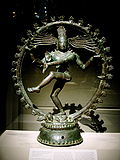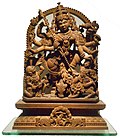Hindu Temple in Sasaram, Bihar
| Maa Tara Chandi Mandir | |
|---|---|
 | |
| Religion | |
| Affiliation | Hinduism |
| Deity | Durga maa Sati, Adi Parashakti, Shakti, Devi, Kali, Parvati, Tara |
| Festivals | Navratri, Maha Shivaratri |
| Governing body | Maa Tara Chandi Temple Committee, Sasaram |
| Location | |
| Location | Sasaram |
| State | Bihar |
| Country | India |
| Geographic coordinates | 24°57′N84°02′E / 24.95°N 84.03°E / 24.95; 84.03 |
| Architecture | |
| Type | Cave temple, mountain temple |
| Completed | Dvapara Yuga |
| Specifications | |
| Temple(s) | 1 |
| Elevation | 110 m (361 ft) |
Maa Tara Chandi Temple is a Hindu temple dedicated to Maa Shakti or Maa Durga, located in Sasaram, Bihar, India. It is one of the 51 Shakta pithas. [1] [2] [3]






